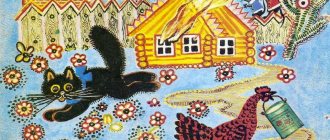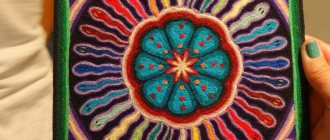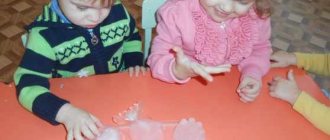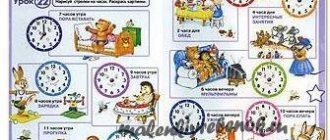The benefits of painting with paints for children
One of the popular creative options for preschoolers is fine art. Teaching a child to draw from an early age has a positive impact on the formation of his personality, helps to develop not only imagination, but also abstract thinking.
The benefits of practicing this type of creativity:
- Development of fine motor skills. Artistic activities require movements of the fingers and hand, which activates areas of the brain responsible for speech, thinking, coordination, and memory. During the drawing process, both hemispheres work, which helps strengthen the connections between them.
- Self-expression. Through drawing, the child projects his inner state onto paper. He expresses thoughts and feelings that he cannot or does not want to express. This allows you to get emotional release and lift your spirits.
- Developing the ability to identify priority goals. In the process of creativity, the child receives a result - a painting. This teaches him to set goals for himself, compare early achievements with past ones and work to improve them.
- Developing patience and perseverance. Systematic painting lessons and working on each drawing teach the child discipline and help structure time.
- Increased self-esteem. Creative activities allow a child to distinguish himself among his peers and feel important.
- Development of creativity. Drawing teaches abstract thinking and contributes to the formation of an individual view of things. Painting not only develops imagination, but also helps to find practical application for new skills.
- Understanding the world around us. Through creativity, the child learns to understand that people can perceive the same objects or phenomena differently and experience different emotions towards them. This develops empathy and social skills.
- Introduction to culture. Learning to draw develops children's taste and aesthetic perception.
- Positive impact on the psyche. Painting classes calm, pacify, and provide an opportunity to productively use accumulated energy. Art lessons are especially useful for children who are aggressive, moody or prone to depression.
In the process of learning to paint, spatial and associative thinking develops, skills of projection onto a plane and orientation in space are developed. This contributes to the mastery of other school subjects and scientific disciplines: mathematics, chemistry, physics, geography, drawing, etc.
Should I send my child to a drawing class?
Today, many parents send their children to specialized clubs. Here the children feel good, as they not only learn artistic activities, but also communicate with their peers. Before you take your child to classes, you need to make sure that he is really interested in this type of art.
Should a child attend a club?
Note! Do not forget that preferences in preschool age are unstable, so today the little one wants to study at an art school, but tomorrow he doesn’t.
Optimal age for skill development
It is best to start teaching children the basics of drawing from an early age - from 6 months to 3 years. During this period, the child should learn the basics, but targeted lessons are not required.
It is enough to provide everything necessary for the development of creative abilities. Games with finger paints improve fine motor skills, imagination, and creativity, which has a positive effect on the formation of not only artistic skills, but also personality.
Targeted drawing training can begin at the age of 5-7 years. During this period, the creative process becomes more meaningful, the child learns to compare and cognize, improving his skills.
Creating a painting turns from a game into a conscious action. At this age, you can begin to work with different types of paints and paper, drawing techniques. This will help you understand what the aspiring artist has the most ability and desire for.
Learning the art of drawing in a playful way.
Image techniques
The method of studying for five years is, first of all, an auxiliary means that does not determine all the specifics of activity in the classroom, and has only a narrow educational significance. For example, if reading a poem (story) at the beginning of a lesson was intended only to arouse interest in the task and attract the attention of children, then in this case the reading served as a technique to help the teacher in solving a narrow task - organizing the beginning of the lesson.
Important! Teaching by example occurs using a specific model and other visual aids. Before completing the task, the teacher must have a conversation with the children. The child learns to look at individual objects and then record his point of view using pencils, paper and other devices.
Educational games for children 6 years old as preparation for school
What techniques are used in practice
What paints are best for children's creativity?
When teaching a child to draw from scratch, it is important to choose the right paints.
The most common types used for children's creativity:
- Finger paint. Made from food coloring and water. Safe for health, easy to wash off, wash and clean from any surface. They have a thick consistency, so they stick well to your fingers and lie smoothly on paper. Suitable for babies aged 6 months and older.
- Watercolor. The most common option for beginning artists, which is most often used in kindergartens and schools. Watercolor paints are made from environmentally friendly materials, are easy to use, and have a bright and rich palette. They easily mix with water and lie on paper in translucent layers, while maintaining richness and juiciness.
- Gouache. Suitable for children aged 5-7 years. It has a dense texture and bright colors when applied to paper. The composition can be either safe or containing toxic substances. For children it is better to choose the first option.
- Oil paints. Valued for ease of use, ease of mixing, and durability of the pattern. They dry without changing color, unlike acrylic or watercolor. Made from vegetable oils. Since economical consumption is important when using such pigments, they are best chosen for children 6-7 years old who are already familiar with the basic rules of painting.
- Acrylic paints. Manufactured from synthetic components. They dry quickly, are easy to dilute and mix, and are suitable for drawing not only on paper, but also on wood or fabric. Acrylic paints are chosen for children 6-7 years old who have already mastered the basics of watercolor painting.
It is better to avoid too bright, acidic tones. Colors should be moderately saturated. The optimal set for a child 6-7 years old is 12-20 shades. Before purchasing, it is recommended to check the paints: they should be moist, uniform in texture, without a sharp, pronounced odor.
Watercolor paints.
Games in a drawing class, a card index of games for art classes in the middle group
Card index of games for art classes in the middle group:
- Theme "Profession"
The lesson is taught using a brush. Ideas about the visual capabilities of paints expand, and the ability to name primary colors is strengthened.
Card index
To complete the work you will need an unpainted rooster drawn and cut out of paper, a landscape sheet with a drawn silhouette of a rooster, red, yellow, blue and green gouache, brushes, jars of water, rags.
The teacher should play up the situation as if an unpainted rooster came to class and said: “Everyone laughs at me, they say that I am unpainted and not real. They told me to go to the artists. They have some paints they can use to paint me.”
Then you need to give the children album sheets with silhouettes of roosters and offer to help them color them, using all four colors in their work.
- Theme "Space"
The teacher teaches children to tint a wet sheet of paper with watercolors, and also to draw dots with the tip of a brush with gouache, conveying the image of a starry sky.
The following materials are needed: sheets of paper for watercolors, gouache, watercolors, thin and wide brushes, jars of water, rags (for each child).
The guys must depict the starry night sky. To do this, use a wide brush to apply a lot of water to the landscape sheet. Then put blue watercolor paint on a brush and tint a sheet of paper. When the paint dries, put yellow or white gouache on the tip of a thin brush and draw stars in the form of dots, as well as a white cloud.
Other tools
For painting, you will also need additional tools.
Their list:
- Brushes. It is better to buy a set of several products of different thicknesses: this will make it easier for your child to realize his creative ideas. For watercolors, choose brushes with natural squirrel or raccoon bristles, and for thicker, more saturated paints, use hard tools with artificial bristles. The holder material that is most comfortable for a child’s hand is wood.
- Paper. For drawings by a novice artist, album sheets of A4 format are suitable. When the child gets comfortable with the basics, it is recommended to replace them with special paper for certain types of paints (for example, watercolor or gouache). This way the pictures will become more juicy and beautiful.
- Palette. This is a device for mixing paints. Made from plastic. On the palette, the child can mix different colors and get new shades without damaging the paper.
- Pencil and eraser. Needed for drawing contours. It is advisable to choose a soft pencil, especially when working with water-based paints.
- Water container. Any cup, glass or jar will do. If your child spills liquid, it is better to buy a special mug with a protective lid.
For convenience, you can purchase a special tablet holder for paper or a small easel. It will teach the child to draw without rotating the sheet, which will be a good help for further artistic training.
Brushes and palette.
Examples of finished works, photo gallery
Here are several finished works with topics interesting for kids:
- "Winter Fun"
Children learn to convey the features of the depicted object using an imprint with crumpled paper. The guys draw the desired image (Snow Maiden) using a brush. As a material, you can use blue cardboard, a container with white gouache, slightly diluted with water, medium-sized lumps of crumpled paper, gouache, brushes, jars of water.
Examples of work with photography
The teacher invites the children to draw a friend for the snow woman in an unusual way - with crumpled paper.
Next, the teacher shows how crumpled paper is lowered into a saucer with white paint and placed several times at the bottom of the cardboard, depicting a round ball. Then draw a small ball in the same way. When the paint dries, you need to finish painting the snow woman’s eyes, carrot nose, and twig hands.
- "Defender of the Fatherland Day»
The guys create a drawing for the holiday using a brush on a wet sheet of paper. Next comes an introduction to a new technique of drawing on a damp sheet of paper. They choose a beautiful paint color to create the desired look. The materials used are paper, watercolors, a brush, a container of water, and napkins.
The teacher invites the children to draw fireworks in honor of the holiday. First, you need to apply water to the landscape sheet with a wide brush. Then put watercolor paint on a thin brush and touch it to a sheet of paper in several places. The dots will begin to spread out. The empty spaces need to be filled with spreading dots of other colors.
What is deviant behavior of preschool children
Note! Make sure that children rinse the brush thoroughly in water.
What should drawings be like for children 6-7 years old and older?
In the drawings of preschoolers and children aged 6-7 years, a clear plot and design begins to be visible. The basis for it is often everyday and social situations from the child’s experience: communication with family, playing with friends at school and kindergarten, visiting a store, hospital and other public places.
Often, motifs from fairy tales or cartoons can be traced; the child depicts literary characters, animals, and familiar places. Children 6-7 years old also draw household objects: furniture, dishes, etc.
The picture of a child reflects his inner state and worldview. Child psychologists advise paying attention to the general mood of the image: it should not be aggressive or depressive.
The constant presence of such motives (sad or quarreling people, large teeth and claws in animals, etc.) may indicate psychological problems.
At 6-7 years old, children should have basic drawing skills. Clear lines with strong pressure, shading and shading that do not go beyond the contour, recognition of the objects and ideas that the artist tried to convey, testify to his correct development.
If the drawings do not meet these criteria, there may be both psychological and physical problems, such as vision problems, neurological disorders, or poor fine motor skills.
Free drawing.
Recommendations from psychologists and teachers
During drawing classes, teachers do not recommend overloading children, otherwise, instead of enjoying a rich and interesting life, the child will suffer from fatigue and frayed nerves. If perseverance is not one of his virtues, then there is no need to force him to study, since he must come to this on his own.
By drawing, the baby develops certain abilities: visual assessment of shape, the ability to navigate in space, and feel colors. In addition, drawing classes bring joy to children and create a positive attitude. To complete easy tasks, you can use online programs.
How to choose a drawing plot for preschool children
When choosing a painting theme for a child, you need to take into account 2 factors: the level of his skills and personal interests.
Popular drawing subjects for preschoolers:
- scenes from fairy tales;
- situations from the life of family and friends;
- visiting public places;
- landscapes, scenes with animals;
- the work of people of various professions - doctors, cashiers, rescuers, etc.
When choosing a plot, it is important to leave the child freedom for creativity. The topic should guide the student's imagination rather than limit it.
Fairy tales.
Palm drawings
Handprint painting is a good way to develop creative thinking in young children.
For this purpose, special paints are used that adhere well to the hand, leave a clear imprint on the paper and are safe in case of accidental ingestion.
With your palms you can draw:
- flower petals;
- branches and crowns of trees;
- other plant parts, such as carrot tops;
- fish, jellyfish and octopuses;
- animals - 4 fingers will be “paws”, and the remaining one will be the tail.
Later, various details are added to the resulting silhouettes with fingers or a brush. The child can do this either independently or with the help of his parents. Drawing with palms develops abstract thinking and helps to see different objects in one simple form.
Palms are an excellent drawing tool.
Workspace organization
Drawing for children aged 4-5 years should take place in a pleasant environment. In order for a preschooler to feel as comfortable as possible at home, he needs to be allocated a special space. The children's room should be well lit, since the rays of light should fall from the opposite side from the hand with which the baby is drawing.
How is work space distributed?
Step-by-step creation of drawings by children
The most important thing in learning any type of creativity is constant practice. Before learning to draw complex, intricate paintings, a child must gain an understanding of simple shapes and the basics of composition.
At the initial stage, learning from ready-made sketches and step-by-step instructions is best for mastering the basics.
They should not limit the imagination and desires of the young artist, but only guide.
Snowflakes and winter ornaments
The image of snowflakes develops imagination and abstract thinking well.
Procedure:
- Draw a circle. Place a dot in the center.
- Focusing on it, cross out the circle horizontally, vertically and twice diagonally - you should get 8 lines inside. This will be the base of the snowflake.
- The blank is filled with circles, lines, zigzags, polygons and other shapes, creating an individual pattern. Similar actions are performed with each beam, maintaining symmetry.
It is worth giving your child creative freedom and the opportunity to draw according to their individual skill level.
Winter motifs in drawings.
Red Apple
Images of fruits and berries are the basis of most educational programs. Using their example, the child understands the basics of lighting and darkening, and color selection.
Steps for drawing a block:
- Draw a circle. Adjust the shape of the top and bottom parts to create the silhouette of an apple. Draw a line (“dimple”) in the upper part, mark the stalk and leaf.
- Apply the first layer of watercolor. It should be light, almost transparent. The apple can be decorated in green, yellow, red colors or a combination of shades at the child’s discretion.
- Color the fruit in a basic tone, skipping areas of highlights.
- Starting from the top of the apple, apply shadows, adding specks of paint and gradually stretching them with a brush.
Having completely painted the base, they begin to draw the stalk and leaf, thicken the outline and other finishing touches.
Fruit still life.
Watermelon gouache
Drawing a watermelon is another easy way to become familiar with basic shapes in painting.
Step-by-step instruction:
- Draw a triangle. Erase one of its sides and replace it with a semicircle, and also make the opposite vertex rounded.
- Inside the resulting outline, select the peel and the layer between the peel and the pulp.
- Paint the main part of the watermelon red. Highlight the layer between the pulp and the peel in green, making a smooth transition.
- Color the peel deep green. Add some dark stripes.
Lastly, you can add a few dark brown and yellow watermelon seeds.
Drawing landscapes
Using paints, it’s easy and quick to paint landscapes - from forests and mountains to the sea or the night sky.
The specifics are different, but the technique remains the same:
- Draw a pencil sketch. It should be as simple as possible and indicate only shapes, without details.
- Paint the background with primary colors: for example, sea and sand or field and sky. Draw large objects such as plants or mountains.
- Apply shadows and highlights. Add surroundings: clouds, waves on the water, etc.
Lastly, small details are completed: seagulls in the sky against the backdrop of the sea, fruits on the trees, etc.
Landscape with colors.





